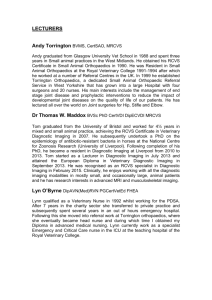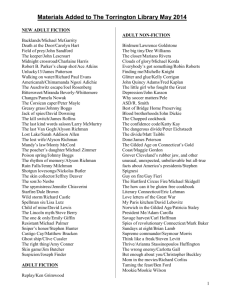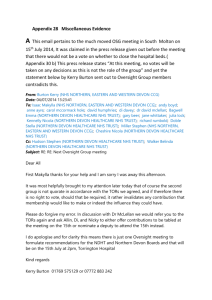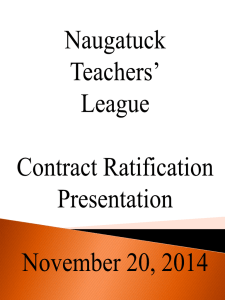Torrington Public Schools
advertisement
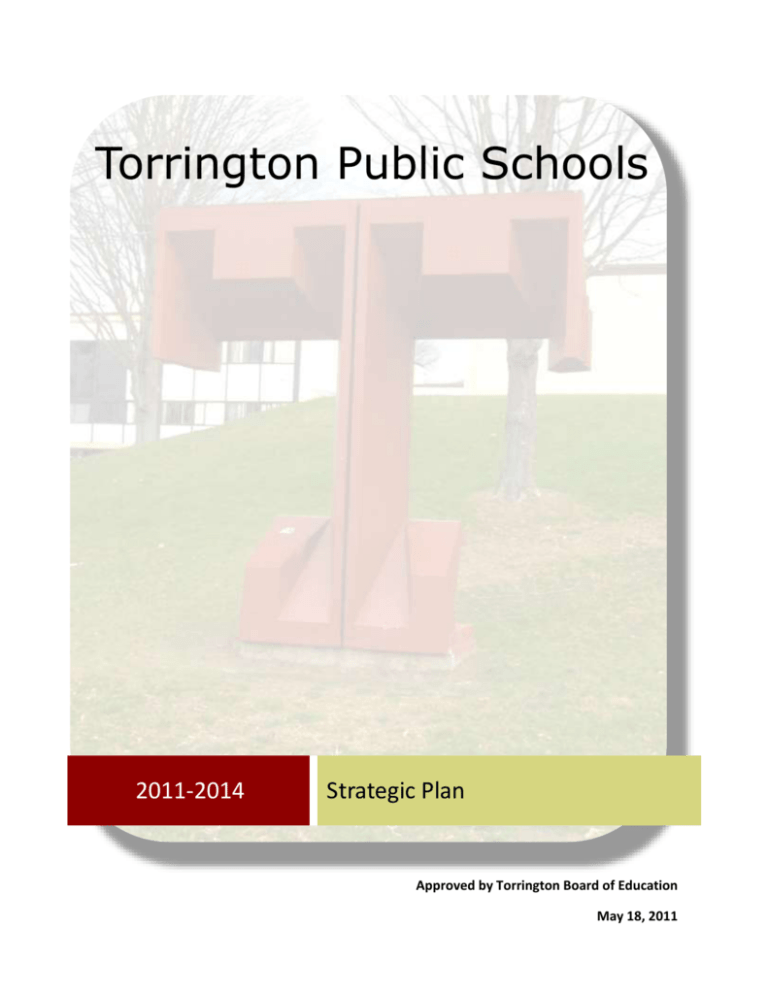
Torrington Public Schools 2011-2014 Strategic Plan Approved by Torrington Board of Education May 18, 2011 Torrington Public Schools Vision Statement The Torrington Public Schools will fully realize success when every child who comes into the district, regardless of individual needs, is able to graduate and enter the college or career of their choosing. “Why a 3-Year Strategic Plan?” A Strategic Plan should be a living document that continues to set goals, measure achievement, adjust future targets, and continue to develop over time. This document is a 3-year strategic plan, but as the district changes, and needs change, so will this plan. While it is a time based plan it is a document, like our children, that will grow over that time and develop to meet the needs of the Torrington Public Schools, its students, the families, and staff. Strategic Plan Goals The following goals were approved by the Board of Education in December 2010 as the framework for the Strategic Plan. They will be updated and revised as necessary over the life of the plan to address the needs of the district. 2|Page Torrington Public Schools Curriculum Goals The Torrington Public Schools will implement a 3-year Curriculum Plan that will have a K-12 scope and sequence for all content areas. The Torrington Public Schools curriculum will clearly define course outcomes at all levels, provide consistency of program through common assessments, contain units that are relevant and rigorous, and integrate technology. The Torrington Public Schools will adopt a technology and text book replacement cycle that is aligned to curriculum needs. Evaluation and Accountability Goals The Torrington Public Schools will retain an exemplary teaching and administrative staff as measured through the completion of data driven staff evaluation tool. All evaluation tools will be aligned to student progress and completed on time in alignment with all contractual provisions. The Torrington Public Schools will annually release “School Report Cards” that measure student progress against the district, DRG, and state. Policy Goals The Torrington Board of Education will review and edit all of its current policies by September 2011. The Torrington Board of Education will ensure that all future policy is written with input from all its stakeholders (parents, staff, and community). 3|Page Torrington Public Schools The Torrington Board of Education will bi-annually review each series for accuracy and efficiency. Financial Goals The Torrington Board of Education will maintain a 3-year Sustainable Budget Plan that reviews and monitors revenue and expenses. The Torrington Public Schools will mitigate deficits as necessary as to maintain a balanced budget for each fiscal year. The Torrington Public Schools will maintain an equitable budget that reviews spending by cost center and by school. The Torrington Public Schools will maintain a 5-year capital plan that includes a facility review once every five years. Alternative Secondary School Goals The Torrington Board of Education will approve Education Specifications and re-open an Alternative High School by August 2012. The Torrington Public Schools will issue annual data on at-risk and drop-out data with the goal of lowering the drop-out rate by 5% over the next three years. The Torrington Public Schools will issue annual data on the Graduation Rate with the goal of increasing that figure by 5% over the next three years. 4|Page Torrington Public Schools Curriculum and Instruction The Torrington Public Schools will implement a 3year Curriculum Plan that will have a K-12 scope and sequence for all content areas. What does this mean for my child? Provides for regular and ongoing evaluation of the instructional program Creates predictability and stability in planning for changes and budgetary needs Assures that course outcomes reflect state standards, are aligned, and are developmental appropriate as students move through the grades What does this look like? How is this Measured? Year 1: A K-12 team defines the Learning Goals for each course Year 2: Grade level or department teams create assessments and develop units to deliver instruction Year 3: Grade levels or departments review student performance data to evaluate effectiveness of curriculum in helping students to achieve grade level expectations Annual updates to the Board of Education on progress and work completed SEE APPENDIX A 5|Page Torrington Public Schools The Torrington Public School curriculum will clearly define course outcomes at all levels, provide consistency of program through common assessments, contain units that are relevant and rigorous, and integrate technology. What does this mean for my child? Greater consistency across schools and classrooms within a grade level in the skills and content covered Better alignment from grade to grade with special attention to transitions from elementary to middle and middle to high school standards and expectations Clarity for teachers to know what to teach and how to measure student achievement Use of technology to create engaging, relevant, and personalized learning experiences for students What does this look like? How is this Measured? Various technology tools such as interactive white boards, classroom response systems, online learning modules, digital cameras and Flipcams, I-pods or other handhelds will be piloted in classrooms in each grade or content area as appropriate Strong curriculum and engaging instruction will result in well-prepared thinkers who are able to experience success Course blueprints (lists of the Learning Goals for each class) will be posted on the Educational Services pages of the district website Guides, assessments, and instructional resources will be available for all of the teachers SEE APPENDIX B 6|Page Torrington Public Schools The Torrington Public Schools will adopt a technology and text book replacement cycle that is aligned to curriculum needs. What does this mean for my child? Students will have access to tools and resources appropriate for the 21st century Instructional materials will be up-to-date and accessible to all students Technology will operate reliably and minimize downtime What does this look like? Older and worn materials will be taken out of circulation. Students will have more technology tools (tablet computers, response systems, audio and video tools) for use in classrooms. Teachers will use a wider variety of instructional formats besides books in instruction. How is it measured? Include funds in annual budget based on recommendations of curriculum teams Maintain an accurate inventory of instructional materials at each school site Track technology deployment and use through asset management tools SEE APPENDIX C 7|Page Torrington Public Schools Evaluation and Accountability The Torrington Public Schools will retain an exemplary teaching and administrative staff as measured through the completion of data driven staff evaluation tool. All evaluation tools will be aligned to student progress and completed on time in alignment with all contractual provisions. What does this mean for my child? Each student benefits as a result of being in a classroom with an exemplary teacher, supervised by exemplary administrators Student achievement benefits from setting clear expectations for improved performance Appropriate student performance data provides an objective measure on which to base accountability By aligning all evaluation tools to student progress and completing the provisions of these tools consistently and on time, Torrington can assure positive student progress in our schools How is this Measured? All teachers and administrators will develop an annual SMART goal. A SMART goal is Strategic and Specific, Measurable, Attainable, Results Oriented, and Time Bound. Goals help educators to improve student achievement by clarifying exactly what students should learn, the standard of learning expected, and the measures used to determine if students have achieved that standard. Each supervisor is responsible for collecting and monitoring goals throughout the school year. All associated documentation will be collected on time as prescribed in the respective evaluation documents. A review of all collected evaluation documents will result in a summative report to the Superintendent of Schools of success of the SMART goals for each teacher and administrator. A review of the quality, timeliness, and fidelity with contractual provisions of all evaluation documentation and procedures will be conducted by the Director of Student and Professional Operations. 8|Page Torrington Public Schools The Torrington Public Schools will annually release “School Report Cards” that measure student progress against the district, DRG, and state. What does this mean for my child? My school? Appropriate student performance data provides an objective measure on which to base accountability. By annually releasing a school report card for each of the Torrington Public Schools, the community will have the ability to review important demographic and performance data. Through clear and transparent reporting of student growth, parents will have the ability to monitor the success of students in each of our schools. Each school that annually falls below 2.5% of the State of Connecticut Average in Math and Reading will be required to submit a quarterly Accountability Plan to the Board of Education. How is this Measured? The report cards will be made available to parents online each summer after student test data is returned to the school district. The report cards will include demographic information on each school, reports on student and teacher attendance, disciplinary reports and student achievement results. 9|Page Torrington Public Schools Board Policy The Torrington Board of Education will review and edit all of its current policies by September 2011. The Torrington Board of Education will ensure that all future policy is written with input from all its stakeholders (parents, staff, and community). The Torrington Board of Education will bi-annually review each series for accuracy and efficiency. What does this mean for my child? My school? The District? The Torrington Public Schools will operate under current policies that are reviewed through a public process that includes access for students, parents, and staff. What does this look like? Policy manual will be current and consistent with all prevailing state and federal statutes. Board of Education policy will be relevant to the needs of students to meet with success. Public meetings will be held on all policy revisions and all stakeholders will have opportunity to provide input in the policy. How is this Measured? Complete review of all policy by August 2011. Following complete review there will be bi-annual review of all policies. Policy Committee revision completed in public meetings. SEE APPENDIX D 10 | P a g e Torrington Public Schools Financial Goals The Torrington Board of Education will maintain a 3-year Sustainable Budget Plan that reviews and monitors revenue and expenses. The Torrington Public Schools will maintain a balanced budget for each fiscal year. The Torrington Public Schools will maintain an equitable budget that reviews spending by cost center and by school. What does this mean for the City? Focus on preserving the Board of Education infrastructure while ensuring efficient use of funds. Require accountability at the district and school level. Foster cooperation among departments and schools as well as the ability to recognize priorities. Sustainable Budget Goals 1) Based on all considerations and uncertainty in the economy, the Torrington Public Schools should budget no more than a 0% increase for FY 2011-2013 2) Based on the escalating benefit costs, the Torrington Public Schools must aggressively pursue Requests for Proposals (RFPs) for FY 2011-2013 3) Considering the demand for academic performance and lower revenue projections, the Torrington Public Schools should collectively bargain performance incentives and benefit changes for FY 2011-2013 4) That when considering the past decade, the Torrington Public Schools cannot sacrifice the following when budgeting: a. Class size b. Materials including textbooks c. Programs including the Arts and Music d. Technology integration and upgrades e. Capital improvements to facilities 11 | P a g e Torrington Public Schools The Torrington Public Schools will maintain a 5-year capital plan that includes a facility review once every five years. What does this mean for the schools? A systematic evaluation of all potential projects that involves multiple stakeholders (Parents, Students, Community, Staff) Capital projects and equipment purchases A planning schedule that holds the district accountable Options for financing the plan How is this Measured? Consolidation of projects to minimize debt and cost Evaluate previously approved, unimplemented or incomplete projects Update existing and ongoing projects 19,290,170 Historical Capital Expenses Expressed As Dollars 22,000,000 21,000,000 20,000,000 19,000,000 880,502 876,502 776,988 803,878 577,000 397,700 105,244 788,966 1,000,000 500,000 0 940,050 18,000,000 06-07 07-08 08-09 09-10 10-11 11-12 12-13 13-14 14-15 15-16 12 | P a g e Torrington Public Schools Alternative School Goals Torrington Board of Education will approve Education Specifications and open an Alternative Secondary School by August 2012. The Torrington Public Schools will issue annual at-risk and drop-out data with the goal of lowering the drop-out rate by 5% over the next three years. The Torrington Public Schools will issue annual data on the graduation rate with the goal of increasing that figure by 5% over the next three years. What does this mean for my child? The District? Over the past three years, the Torrington Public Schools has held a 4-year cumulative dropout rate as high as 18%. This number has increased since the closure of an Alternative School in 2004. The creation of an alternative secondary school will provide education options for all students in the district. With a concentration on lowering the dropout rate and increasing the graduation rate, the district will provide an overall healthier secondary education experience for all students. How is this Measured? The Board of Education has an approved goal to reopen an Alternative High School by August of 2012. The district, as part of its Secondary Reform Panel, will annually publish results against the 4-year cumulative drop-out number. The district, as part of its School-Based Report Card for Torrington High School, will publish the graduation rate and the cohort graduation rate as measured against previous years, the District Reference Group, and the State of Connecticut. 13 | P a g e Torrington Public Schools GLOSSARY OF TERMS Assessments: tools used to check student mastery of learning including formative assessments to check for understanding and inform instruction and summative assessments given at the end of instruction to measure mastery Blueprints: lists of specific learning targets or goals for a course Capital Plan: estimate of expenses to maintain or upgrade buildings and facilities Common Core Standards (CCS): set of national learning goals for Math and English Language Arts courses at each grade level that defines clear learning goals adopted by the Connecticut State Department of Education in 2010 Connecticut Academic Performance Test (CAPT): A state-developed assessment given to all Grade 10 students that measures student competency in Reading Across the Disciplines, Writing Across the Disciplines, Mathematics, and Science Connecticut Mastery Test (CMT): A state-developed assessment given to all students in Grades 3-8 that measures mastery of standards in Mathematics, Reading, Writing, and Grade 5 and 8 Science Connecticut State Department of Education (CSDE): agency that governs professional practice, teaching and learning standards, data, and student assessment for all Connecticut public schools Course outcomes: learning goals, what all students will know and be able to do Curriculum: plan that identifies what knowledge and skills students will learn in a course Data-driven staff evaluation tool: process to determine teacher and administrator performance level based on student outcomes including growth and achievement DRG: District Reference Group. Towns and cities of similar size that share a similar demographic profile including student characteristics and income and educational level of residents Educational Specifications: a detailed plan that describes all aspects of school operation: how it is managed, curriculum, facility, students served, staffing model Professional Learning Communities (PLC): A philosophy and set of structures that supports teacher collaboration focused on improved practice and improved outcomes for students SMART goal: a target that is specific, measurable, achievable, relevant, and time-bound Student performance data: various measurements of achievement in Reading, Math, Writing, and other content areas including the Connecticut Mastery Tests (CMT), Connecticut Academic Performance Test (CAPT), district developed tests, and teacher developed tests 14 | P a g e Torrington Public Schools APPENDIX A 2010-11 2011-12 2012-13 2013-14 2014-15 Math Develop blueprints & pacing guides, conduct CCS* gap analysis Start to migrate topics as needed in blueprints, develop resources and strategies menus Complete alignment with new CCS, adjust blueprints, pacing Repeat cycle with K-12 articulation team. Revisit CSDE frameworks Science Develop blueprints & pacing guides, conduct CCS* gap analysis Start to migrate topics as needed in blueprints, develop resources and strategies menus Complete alignment with new CCS, adjust blueprints, pacing Repeat cycle with K-12 articulation team. Revisit CSDE frameworks English Language Arts Develop blueprints & pacing guides, conduct CCS* gap analysis Start to migrate topics as needed in blueprints, develop resources and strategies menus Complete alignment with new CCS, adjust blueprints, pacing guides Repeat cycle with K-12 articulation team. Revisit CSDE frameworks Social Studies Develop blueprints & pacing guides, conduct CCS* gap analysis Start to migrate topics as needed in blueprints, develop resources and strategies menus Complete alignment with new CCS, adjust blueprints, pacing guides Repeat cycle with K-12 articulation team. Revisit CSDE frameworks Develop blueprints & pacing guides, conduct CCS* gap analysis. Revisit Grade 612 World Language themes to be supported, not driven by text series. Assure Health includes all state mandated topics. Align career completers with state assessments Start to migrate topics as needed in blueprints, develop resources and strategies menus Complete alignment with new CCS, adjust blueprints, pacing guides Non-core 2015-16 Repeat cycle with K-12 articulation team. Revisit CSDE frameworks *CCS: Common Core Standards 15 | P a g e Torrington Public Schools APPENDIX B 2010-11 Math Instruction Assessment Science 2011-12 English/ Language Arts 2013-14 Investigate course sequence and foster heterogeneity Core and enriched curriculum for grades 6 & 7, academic/college/accelerated for grades 8-12 Support through coaching, walkthroughs, and teacher PLC Develop formative & summative assessments, including CMT/CAPT-like problems Investigate course sequence Calibrate scoring of district assessments for consistency & validate data Administer and refine common assessments to collect data to inform instruction Realign topics to match new standards and assessments Support through coaching, walkthroughs, and teacher PLC Develop formative & summative assessments Calibrate scoring of district assessments for consistency & validate data Administer and refine common assessments to collect data to inform instruction Revisit CSDE assessment changes & blueprints Investigate balanced literacy, workshop model, best practices in vocabulary instruction Foster heterogeneity, support differentiation through coaching Realign topics to match new standards and assessments Calibrate scoring of district assessments for consistency & validate data Support through coaching, walkthroughs, and teacher PLC Instruction Assessment 2012-13 Instruction 2014-15 Revisit CSDE assessment changes & blueprints Assessment Develop formative & summative assessments including CMT/CAPT-like questions/prompts Social Studies Revisit K-12 sequence to reduce gaps and redundancies in Geography, U.S. History, World Civilizations/History themes Realign topics to match new standards and assessments Support through coaching, walkthroughs, and teacher PLC Develop formative & summative assessments Calibrate scoring of district assessments for consistency & validate data Administer and refine common assessments to collect data to inform instruction Revisit CSDE assessment changes & blueprints Utilize performance based, project based strategies Realign topics to match new standards and assessments Support through coaching, walkthroughs, and teacher PLC Instruction Assessment Non-core Instruction 2015-16 Administer and refine common assessments to collect data to inform instruction Revisit CSDE assessment changes & blueprints 16 | P a g e Torrington Public Schools 2010-11 Assessment 2011-12 2012-13 2013-14 2014-15 Develop formative & summative assessments Utilize state developed common assessments in the Arts. Utilize state assessments in CTE areas Calibrate scoring of district assessments for consistency & validate data Administer and refine common assessments to collect data to inform instruction 2015-16 Revisit CSDE assessment changes & blueprints APPENDIX C 2010-11 Math Textbooks (Instructional Resources) Science Textbooks (Instructional Resources) English Language Arts Textbooks (Instructional Resources) Social Studies Textbooks (Instructional Resources) Non-core Textbooks (Instructional Resources) 2011-12 Pre-calculus/Trig instructional materials (texts, supplemental materials, technology) 2012-13 2013-14 2014-15 2015-16 Algebra & Calculus (texts, Pre-Algebra & Geometry Review elementary supplemental materials, (texts, supplemental Math program: Growing technology) materials, technology) With Mathematics (supplemental materials and technology) Science non-fiction books Leveled materials, Review Chemistry & Review elementary by topic for Grade 6-8 inquiry materials Expand Physics (texts, resources: integrate instructional materials online/blended learning- supplemental materials, Science non-fiction in (texts, supplemental Biology, Integrated technology) reading (supplemental materials, technology) Science (texts, materials and supplemental materials, technology) technology) Young adult core novels- Young adult core novels- Young adult core novels- Continue to expand trade Grades 9-10, non-fiction Grades 11-12, GHGR Grades 6-8 books, review GHGR leveled books, GHGR Grade 5 (strategic reading texts, program Grade 4 (vocabulary texts, supplemental materials, (vocabulary texts, supplemental materials, technology) supplemental materials, technology) technology) Review/align US History Review/align World Review Geography/map Grades 5,8, 11 ( texts, History/Culture Grades 4, skills Grades 2, 3, 7 ( supplemental materials, 6, 10 texts, supplemental technology) ( texts, supplemental materials, technology) materials, technology) Review Spanish series, Review Latin & Italian Review French series. Utilize Perkins funds to series. Utilize Perkins Utilize Perkins funds to update to industry funds to update to update to industry standards (texts, industry standards standards (texts, supplemental materials, (texts, supplemental supplemental materials, technology) materials, technology) technology) . 17 | P a g e Torrington Public Schools APPENDIX D POLICY REVIEW TIMELINE GOAL: To review the Torrington Board of Education Policy Book during the 2010-2011 school year. July 2010 Series 1000 – Review for Action at Policy Committee Level August 2010 Series 1000 – Edits at Policy Committee Series 2000 – Review for Action at Policy Committee Level September 2010 Series 1000 – Changes to BOE Series 2000 – Edits at Policy Committee Series 3000 – Review for Action at Policy Committee Level October 2010 Series 2000 – Changes to BOE Series 3000 – Edits at Policy Committee Series 4000 – Review for Action at Policy Committee Level November 2010 Series 3000 – Changes to BOE Series 4000 – Edits at Policy Committee Series 5000 (5000-5040) – Review for Action at Policy Committee Level December 2010 Series 4000 – Changes to BOE Series 5000 (5000-5040) – Edits at Policy Committee Series 5000 (5040-End) – Review for Action at Policy Committee Level January 2011 Series 5000 (5000-5040) – Changes to BOE Series 5000 (5040-End) – Edits at Policy Committee Series 6000 (6000-6050) – Review for Action at Policy Committee Level February 2011 Series 5000 (5040-End) – Changes to BOE Series 6000 (6000-6050) – Edits at Policy Committee Series 6000 (6070-6100) – Review for Action at Policy Committee Level 18 | P a g e Torrington Public Schools March 2011 Series 6000 (6000-6050) – Changes to BOE Series 6000 (6070-6100) – Edits at Policy Committee Series 6000 (6105-6120) – Review for Action at Policy Committee Level April 2011 Series 6000 (6070-6100) – Changes to BOE Series 6000 (6105-6120) – Edits at Policy Committee Series 6000 (6130-6182) – Review for Action at Policy Committee Level May 2011 Series 6000 (6105-6120) – Changes to BOE Series 6000 (6130-6182) – Edits at Policy Committee Series 6000 (6184-END) – Review for Action at Policy Committee Level June 2011 Series 6000 (6130-6182) – Changes to BOE Series 6000 (6184-END) – Edits at Policy Committee Series 7000 – Review for Action at Policy Committee Level July 2011 Series 6000 (6184-END) – Changes to BOE Series 7000 – Edits at Policy Committee Level August 2011 Series 7000 – Changes to BOE 19 | P a g e
